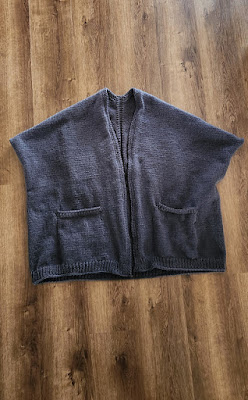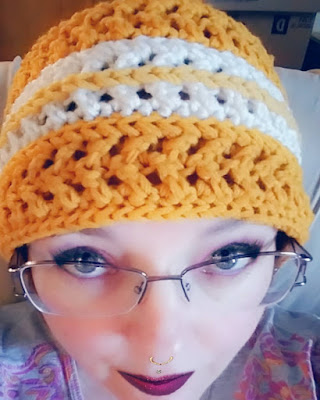I’m living with a lot of stress right now, so I needed a project that could not only use up some of my yarn stash but also was relatively simple to execute without needing a lot of concentration.
I enjoyed seeing all the various shawls people created during Marly Bird’s
2019 Tournament of Stitches, so I decided to adopt the boomerang shape used for that project, but instead of incorporating the mosaic sections I decided to keep it simple by working the entire piece in a two-color garter stitch stripe.
The two yarns I used here are both vintage skeins that date back to my mother’s stash. She very likely purchased these before I was even born. Even though the colors aren’t my favorite, I think they work well together and hopefully will result in a nice-looking scarf that my daughter will enjoy wearing.
My plan was just to keep knitting until I was about to run out of yarn, then cast off. I figured the two full skeins of yarn ought to produce a nice-sized scarf when it was all finished.
Just to mix things up a bit and make the long stretches of garter stitch more interesting toward the end (as well as to add visual interest on one side of the triangle in keeping with the scarf’s Honeydripper theme), when my yarn was about 75% gone I started working occasional honeycomb lace rows. This did add an additional level of detail to the process, but it was easy enough for me to read my knitting and see when it was time to work the lace rows, so I didn’t think this would be too much for my overtaxed brain to cope with.
Continuing with the increases/decreases on every RS row and alternating stripes of color as established, every sixth row (always a WS return row) I would work in honeycomb lace. Placing the lace rows this way ensured that the lace rows would be produced in alternating yarn colors, helping to keep the overall usage of each color as even as possible.
I think I can hear what you’re wondering: Why didn’t I work the whole scarf with the lovely honeycomb lace, or if not the whole scarf, why didn’t I at least start working the lace sooner - like around the halfway point? My only reply to this is: I just did it this way. End of story. If you want to copy my idea you can work as much lace (or as little) as you like. 😊
After finishing the scarf (wingspan is about 78 inches) I ended up with a bit more of the darker Inca Gold yarn left than the lighter gold. I decided to see if it was enough to crochet a coordinating
Chic Aran Headband to go with the scarf. 😁
Well, I didn’t have quite enough Inca Gold to do the entire headband, and I didn’t have enough of the pale gold to do an entire stripe, so I subbed in some aran white for the center rows 6, 3, 4, and 5. That left me enough Inca Gold to finish the headband, and I embroidered a simple chain stitch as an accent down the center of the white stripe with the pale gold to add a touch of that color to the headband as well. Yay!
































